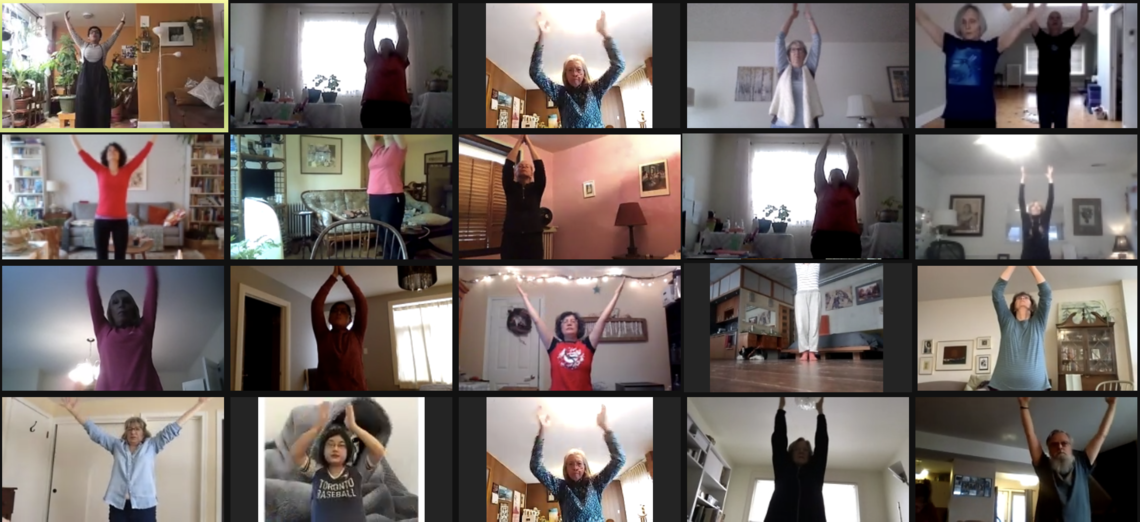May 21, 2021
Organized dance activities help older adults suffering from COVID-19 loneliness, study finds

Older adults who are struggling with body issues often felt by aging populations and suffering from loneliness, made worse over the past year by the isolation of COVID-19, can benefit greatly from dance interventions, according to a UCalgary-authored pilot study in the journal Frontiers in Psychology.
“We found that collaborative, memory-based dance interventions have a positive effect on older adults in the areas of social inclusion and body appreciation,” says Dr. Pil Hansen, PhD, an associate professor in the School of Creative and Performing Arts (SCPA) and lead author of the study.
Dance interventions lead to new social connections, and given the negative impact of COVID-19 on aging populations we recommend such initiatives. They can help older adults regain the comfort levels and confidence necessary to make social connections again.
The interdisciplinary study — which partners UCalgary researchers with Toronto dance company Kaeja d’Dance — tests the effects of organized dance activities that are “designed to facilitate embodied social connections” among older adults. In this case, the dance activity Moving Connections was designed by Karen Kaeja. The co-authors of the study are MFA and MSc students Caitlin Main and Liza Hartling, with SCPA and the Werklund School of Education, respectively. Dr. Candace Konnert, PhD, head of the Department of Psychology’s Healthy Aging Lab, also provided consultation.
While the study began before the pandemic, with the interventions held in a dance studio, the coming of COVID-19 necessitated a significant pivot, with Kaeja d’Dance moving the dances online, via Zoom, and to Toronto parks where social distancing could be maintained.

Karen Kaeja's Moving Connections, taught by Irma Villafluerte. Dance interventions like these have proven to have a great benefit to older adults suffering from loneliness, enhanced during COVID-19.
Courtesy Kaeja d'Dance
With the guidance of professional dancers, participants created movements and choreography that expressed their respective autobiographical memories of meeting and connecting with a new person.
“One participant talked about the first moment someone special caught her heart,” says Hansen. “She created three gestures representing that moment. These gestures could be made with any part of the body. The gestures were then blended together into one fluid movement phrase, those phrases becoming part of a larger choreography.”
Hansen explains that every participant in the group learns each other’s gestures and shares their deeper meanings. “What happens is that through the dance participants connect with each other’s memories,” she says. “It brings them together in a deep and meaningful way.”
The dance interventions also have great value in helping older adults feel better about their bodies, Hansen adds.
“In our society aging bodies are considered less attractive and less valuable and that’s often internalized by older adults,” says Hansen. “They begin to believe this about themselves.”
Of course, as bodies age there is often “a loss of physical capacity,” notes Hansen. “You may have less mobility or a fear of falling and feel like you can’t dance because, maybe, you have to sit in a chair while doing so. All of this can present barriers.”
However, with dance interventions specifically tailored for each participant, these barriers can be overcome, Hansen says. “When they’re interacting with one another in this way, older adults begin to feel strength in these new connections, being able to express their personal memories with their bodies. Seeing those personal memories expressed by their fellow dancers is also very impactful. Attention is shifted from a negative experience of the body to one that is positive and empowering.”
Given the positive effects the study documents, with dance interventions improving body appreciation and leading to new social connections among older adults — even as COVID-19 enhanced their isolation — Hansen recommends that such methods could be widely used.
“I could see this being introduced in seniors' homes and community health centres,” she says. “The interventions could be adapted to the needs of specific seniors' groups, for example, those with dementia, Alzheimer’s or Parkinson’s disease.”
“These dance interventions have a lot to offer older adults who have much to overcome. Especially in the midst of a pandemic, as vaccines roll out.”
The research in this study was funded by SSHRC and the Faculty of Arts. The dance program was funded by the Ontario Trillium Foundation.




